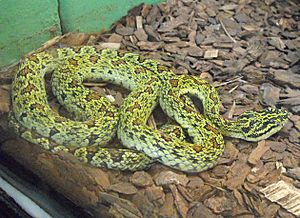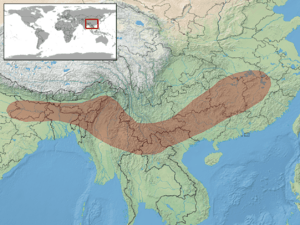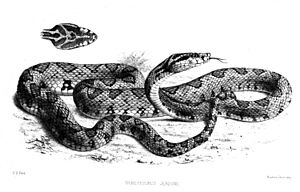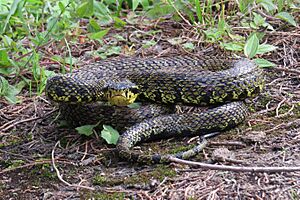Protobothrops jerdonii facts for kids
Quick facts for kids Protobothrops jerdonii |
|
|---|---|
 |
|
| at the San Diego Zoo | |
| Conservation status | |
| Scientific classification | |
 |
|
| Synonyms | |
|
The Jerdon's pitviper (scientific name: Protobothrops jerdonii) is a type of venomous snake. It is also known as the yellow-speckled pit viper or oriental pit viper. This snake belongs to the pit viper group, which is part of the viper family.
You can find Jerdon's pitviper in several countries. These include India, Nepal, Myanmar, China, and Vietnam. There are three main types, or subspecies, of this snake.
Contents
What's in a Name?
The name jerdonii honors a British expert on reptiles and amphibians, Thomas C. Jerdon. He was the one who first collected these snakes for study.
One of the subspecies, bourreti, is named after a French expert, René Léon Bourret. Scientists often name new species after people who helped discover or study them.
About the Jerdon's Pitviper

Jerdon's pitvipers can grow to be quite long. Male snakes can reach about 83.5 centimeters (about 33 inches) in total length. This includes their tail, which can be around 14 centimeters (about 5.5 inches) long.
Female snakes are usually a bit longer. They can grow up to 99 centimeters (about 39 inches) long. Their tails can be about 16 centimeters (about 6.3 inches) long. These snakes have special scales on their bodies and heads.
Where They Live
Jerdon's pitvipers live in parts of Asia. They are found in northeastern India and Nepal. Their home also extends through northern Burma (now Myanmar) into southwestern China and Vietnam. The first snake of this type was found in the Khasi Hills in India.
Different Types of Jerdon's Pitviper
There are three recognized subspecies of Jerdon's pitviper. Each subspecies has a slightly different home range.
| Subspecies Name | Common Name | Where They Are Found |
|---|---|---|
| P. j. bourreti | Bourret's pitviper | Northwestern Vietnam (in areas like Lào Cai and Lai Châu provinces). They might also live in nearby parts of China (Yunnan). |
| P. j. jerdonii | Jerdon's pitviper | Southwestern China (southern Tibet, western Sichuan, and Yunnan). Also in northeastern India, Bangladesh, Burma (Chin and Kachin state), and northeastern Nepal. |
| P. j. xanthomelas | Red spotted pitviper | Central and southern China (in provinces like Henan, Shaanxi, Gansu, Sichuan, Guizhou, Hubei, and Guangxi). Also found in northeastern India (Arunachal Pradesh). |



